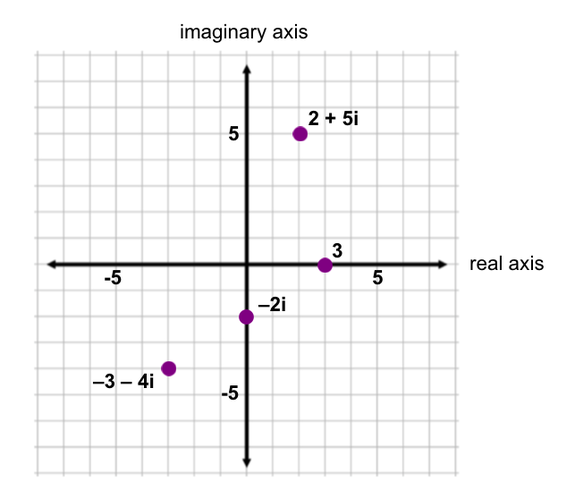Table of Contents |
A complex number is a number that contains a real part and an imaginary part, such as  . In mathematics, we deal with real numbers all the time. These are numbers that we can place on the number line, such as integers, decimals and fractions, and rational and irrational numbers. An imaginary number is not real, and contains the imaginary unit i, which is
. In mathematics, we deal with real numbers all the time. These are numbers that we can place on the number line, such as integers, decimals and fractions, and rational and irrational numbers. An imaginary number is not real, and contains the imaginary unit i, which is  . This is non-real because every real number squared is non-negative. So when a negative number is underneath a square root, there is no real number that it evaluates to.
. This is non-real because every real number squared is non-negative. So when a negative number is underneath a square root, there is no real number that it evaluates to.
In general, we write complex numbers in the form  .
.  is the real number component to the complex number, and
is the real number component to the complex number, and  is the imaginary number component to the complex number. Complex numbers represent a larger set of numbers than real numbers do, because the complex number system includes real numbers, and also includes the set of all imaginary numbers as well.
is the imaginary number component to the complex number. Complex numbers represent a larger set of numbers than real numbers do, because the complex number system includes real numbers, and also includes the set of all imaginary numbers as well.
 , containing a real part,
, containing a real part,  , and an imaginary part, bi, where i is the imaginary unit,
, and an imaginary part, bi, where i is the imaginary unit,  .
.We can represent complex numbers on what is called the complex plane. It is similar to the coordinate plane we use for graphing, but instead of x- and y-axes, we have a real axis and an imaginary axis. This is shown below:

We can plot complex numbers on the complex plane following a very similar process for plotting coordinate points (x, y) on the coordinate plane.
EXAMPLE
Plot the following points on the complex plane:




 and
and  . These numbers lie on one of the axes of the plane because they are either purely imaginary (having no real component) or purely real (having no imaginary component).
. These numbers lie on one of the axes of the plane because they are either purely imaginary (having no real component) or purely real (having no imaginary component).
There is an interesting pattern with the powers of the imaginary unit, i. The pattern is cyclical, which means that it repeats in cycles. Let's examine the first four powers of i:
| Power of i | Calculation | Result |
|---|---|---|

|

|

|

|

|

|

|

|

|

|

|

|
At this point, as we continue to increase the exponent by one, the powers of i repeat this cycle: 

Source: ADAPTED FROM "BEGINNING AND INTERMEDIATE ALGEBRA" BY TYLER WALLACE, AN OPEN SOURCE TEXTBOOK AVAILABLE AT www.wallace.ccfaculty.org/book/book.html. License: Creative Commons Attribution 3.0 Unported License